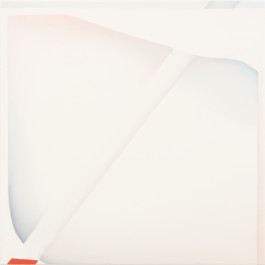MORPHOGENESIS – FORM FOLLOWS INTENTION
„It is the pervading law of all things organic and inorganic, of all things physical and metaphysical, of all things human and all things superhuman, of all true manifestations of the head, of the heart, of the soul, that the life is recognizable in its expression, that form ever follows function.“
Louis Henry Sullivan, ( 1856- 1924, Architect)

MORPHOGENESIS XIV
2020, 80 X 80 CM, OIL ON CANVAS
Morphogenesis (griechisch μορφογενετική)
(„Ursprung der Form“) beschreibt die Entwicklung von Organismen, Organen und Organellen sowie anderer Strukturen und Merkmale im Verlauf der Entwicklung der Lebewesen wie dem Menschen, Tieren, Pflanzen, Prokaryoten und Viren.
Was ist eine Form und welche Bedeutung hat die Form in Bezug auf die Wahrnehmung und in der Folge auf die Erkenntnis?
Prof. Dr. rer. nat. Erich Sackmanns (TU München) Forschungen an der Zelle ergaben, daß Proteine Formen erkennen können und aufgrund dieses
Erkennens ihre Form verändern – auf das Erkannte reagieren. Es existiert also ein „Fühlen“ auf der molekularen Ebene. Da also die Wahrnehmung in einer Wechselwirkung zur Form steht, stellt sich die Frage, ob die Form selbst schon ein Kommunikationsmittel ist. Und was bedeutet es, dass in meinen Zellen unabhängig von meinem Bewusstsein Wahrnehmung stattfindet und Entscheidungen getroffen werden können?
Von 2012 bis 2017 führte ich eine Reihe von Gesprächen mit dem Biophysiker Prof. Sackmann (TUM) über die Morphogenese und die Evolution. Ich fragte Prof. Sackmann, woher die Formenvielfalt in der Natur kommt und wie und warum sich die Formen so und nicht anders entwickelt haben.Gibt es aus wissenschaftlicher Sicht ein Konzept, ein System, das der Entstehung der lebendigen Formenwelt zugrunde liegt? "Es hängt alles von den Kräften ab, von der Stabilität und der Effizienz aber da ist noch ein großer Spielraum. Die Natur spielt. Sie singt eine kosmische Melodie."
Die Serie "MORPHOGENESIS" untersucht die Formen und Oberflächen – Haut, Körperlichkeit, Innen, Außen. Es ist ein Herantasten an eine Formensprache des Lebendigen und an die Suche nach dem Moment der Veränderung.Der Evolutionssprung ist ein singulärer Moment, wo zufällig nach vielen Versuchen und Variationen der Entwicklung eine intelligente Lösung für eine bisher unlösbare Aufgabe
auftaucht. Die lebensbedrohliche Krise ist überwunden und ab sofort ist die Lösung in das Erbgut eingeschrieben und wird an alle nachkommenden Lebewesen weitergegeben.. Ist die Innnovation in der Welt, wird sie weitergegeben. Und häufig löst genau sie wiederum bei anderen Lebewesen eine neue Krise aus. So schaukelt sich das Leben vom ersten Molekülhaufen zu immer komplexer werdenden Organismen von einer Krise zur nächsten weiter und spielt.
Prof. Dr. rer. nat. Erich Sackmanns gilt als der Begründer der Biophysik in Deutschland. Er ist ehemaliger Ordinarius für Experimentalphysik, bekannt für seine Forschung an den physikalischen Grundlagen der Selbstorganisation und der Funktion künstlicher und biologischer Membranen sowie der Physik der Zelle.
Morphogenesis (Greek μορφογενετική)
("origin of form")
describes the development of organisms, organs and organelles, and other structures and features in the course of the evolution of living things such as humans, animals, plants, prokaryotes, and viruses.
What is a form and what is the significance of form in relation to perception and subsequently to cognition?
Prof. Dr. rer. nat. Erich Sackmann's (TU Munich) research on the cell revealed that proteins can recognize shapes and change their shape based on this recognition – react to what they recognize. So there is a "feeling" on the molecular level. So, since perception interacts with form, the question arises whether form itself is already a means of communication. And what does it mean that perception takes place and decisions can be made in my cells independent of my consciousness?
From 2012 to 2017, I had a series of conversations with biophysicist Prof. Sackmann (TUM) about morphogenesis and evolution.
I asked Prof. Sackmann where the diversity of forms in nature comes from and how and why forms evolved the way they did and not differently. From a scientific point of view, is there a concept, a system, that underlies the origin of the living world of forms? He answered: "It all depends on the forces, on the stability and efficiency but there is still a big margin.
Nature is playing. She sings a cosmic melody."
The series "MORPHOGENESIS" explores the forms and surfaces – skin, physicality, inside, outside. It is an approach to a formal language of the living and to the search for the moment of change.The evolutionary leap is a singular moment, where by chance, after many attempts and variations of development, an intelligent solution for a previously unsolvable task emerges. The life-threatening crisis is overcome and from now on the solution is inscribed in the hereditary material and will be passed on to all descendant living beings...Once the innovation is in the world, it is passed on. And often it triggers a new crisis in other living beings. In this way, life continues to swing from one crisis to the next, from the first heap of molecules to increasingly complex organisms, playing perpetually.
Prof. Dr. rer. nat. Erich Sackmanns is considered the founder of biophysics in Germany. He is a former full professor of experimental physics, known for his research on the physical basis of self-organization and the function of artificial and biological membranes as well as the physics of the cell.

MORPHOGENESIS I
2017, 140 X 140 CM, OIL ON CANVAS

Morphogenesis, XV, 2020, 60 x 50 cm

AMORPHIA
2020, 70 x 50 cm, oil on canvas

MORPHOGENESIS XIV
Three is more thAn two
2020, 60 X 50 CM, OIL ON CANVAS

ONE IS THE PLACE
2022, 70 X 70 CM, OIL ON CANVA

IF MATTER DIDN`T EXIST, 2016, 120 x 100 cm

WHO ARE YOU NOW I/II, 2021, 50 X 50 CM, OIL ON CANVAS

MORPHOGENESIS VI
2018, 70 x 70 cm, oil on canvas


MORPHOGENES III
2020, 100 x 100 cM, oil on canvas